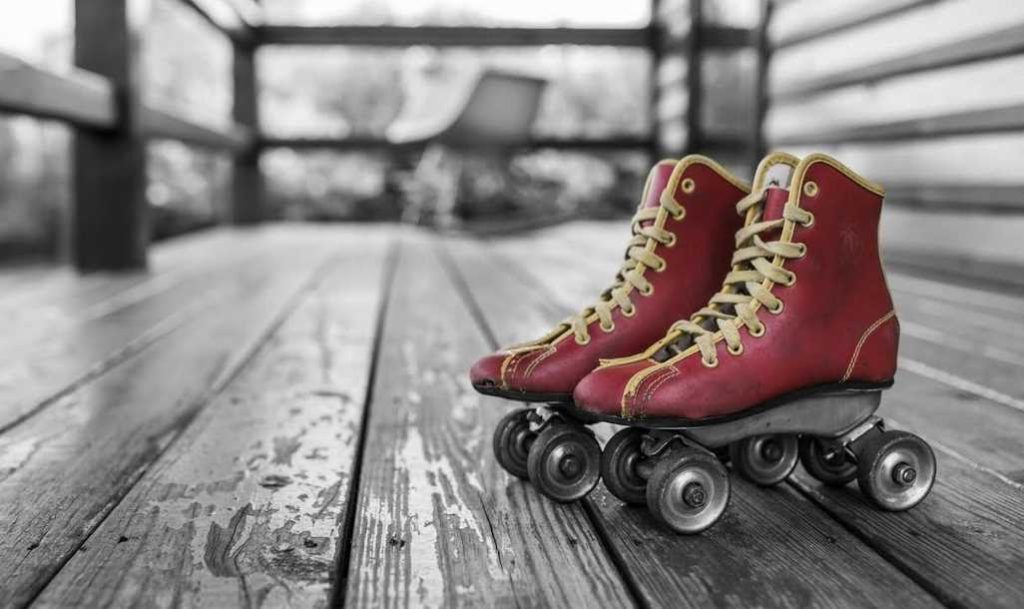Life Style
Different Types of Roller Skates: How to Choose the Perfect Pair

Did you know that during the coronavirus pandemic, the popularity of roller-skating surged?
There are a lot of different types of roller skates on the market, and it can be tough to figure out which pair is right for you. Do you need speed skates or recreational skates? Quad skaters or inline skaters?
Don’t worry. Keep reading because our guide will help you explore the different types of roller skates and decide which pair is perfect for your needs.
We’ll teach you how to choose the right size, style, and features for your skating adventures.
Inline Skates
Inline skates, also known as blade skates, are a type of skate that has three or more wheels arranged in a single line. Unlike traditional roller skates, which have two wheels side-by-side, inline skates offer greater speed.
As a result, they’re often favored by experienced skaters who are looking for a challenging skating experience. In addition to being great for speed and agility, inline skates are also relatively easy to control.
Thanks to their inline design, they tend to track in a straight line when compared to traditional skates.
Quad Skates
These are the traditional style of roller skate, with two rows of four wheels each. Quad skates are stable and easy to control, making them a good choice for beginners or those who want a leisurely skate.
High-Top Skates
High-top skates are a popular choice for beginners or those with weaker ankles. As the name suggests, they have a taller boot that extends up the calf. This offers more support than other types of roller skates.
In addition, high-top skates typically have a softer boot, which makes them more comfortable to wear. However, one downside of high-top skates is that they can be more difficult to break in.
Low-Cut Skates
Low-cut skates have a shorter boot that doesn’t extend as high up the calf. They’re lighter and more comfortable than high-top skates, making them a good choice for experienced skaters who want a faster skate.
Speed Skates
Speed skates are designed for racing and have a sleek, low-cut design. They’re not suited for beginner or recreational skating, but if you’re looking to go fast, they’re the skates for you.
Roller Blading vs Roller Skating?
The difference is between roller blading and roller skating, it’s all in the skates. Roller blades, or inline skates, have three or more wheels arranged in a single line, while quad skates have two rows of four wheels each.
Roller blades are great for speed and maneuverability, making them ideal for experienced skaters, while quad skates are stable and easy to control, making them a good choice for beginners or those who want a leisurely skate.
So, whether you’re looking to race around the rink or just cruise around the block, there’s a pair of roller skates that’s right for you.
Whichever type of skate you choose, always be sure to wear protective gear to avoid injuries. With a little practice, you’ll be skating like a pro in no time!
If you want to learn tricks, you can see the best roller skating tricks for beginners here.
Where to Buy Roller Skates?
Now that you know what type of roller skates you need, it’s time to find a pair that fits your style. You can buy roller skates online or at your local sporting goods store.
If you’re buying skates for the first time, it’s best to go to a store so you can try on different sizes and styles to find the perfect fit. Once you know your size and preferred skating style, you can buy skates online or at a brick-and-mortar store.
There are a few things to keep in mind when shopping for roller skates. First, make sure to buy the right size. Skates that are too big or too small will be uncomfortable and can cause blisters or other injuries. Second, consider the type of skating you’ll be doing.
If you’re mostly skating for fun, recreational skates are a good option. But if you’re interested in doing tricks or racing, you’ll need a more specialized skate. Finally, think about your budget.
Skates can range in price from around $100 to $300 or more, so it’s important to find a pair that fits both your needs and your budget. How to Care for Roller Skates?
Once you have your perfect pair of roller skates, it’s important to take care of them, so they last for years. Here are some tips on how to care for your skates:
- Store them in a cool, dry place when you’re not using them
- Clean the wheels and bearings regularly with soap and water
- Don’t leave your skates in direct sunlight, as this can damage the wheels
- Periodically check your skates for any loose parts or damage
By following these simple tips, you can keep your roller skates in tip-top shape for years to come!
Learn More About These Types of Roller Skates
Roller skating is a fun, relatively inexpensive way to get some exercise and have a good time. Whether you’re new to the sport or upgrading an old pair of skates, it’s important to choose the right type of skate for your needs.
In this article, we’ve explored the different types of roller skates available on the market today.
We hope this information helps you make an informed decision about which pair is best for you. Be sure to check out our blog for more helpful articles like this one!
Life Style
Do Infants Sleep More When Teething? Understanding Sleep Patterns During Teething


Knowing how teething impacts an infant’s sleep is actually pretty crucial if you’re trying to get through those rough patches. This phase? Definitely a rollercoaster for babies—and their parents too. You might wonder, do infants sleep more when teething, or does all that fussiness keep them up way past their bedtime? It kind of depends, but understanding the bigger picture can really help you be there for your little one in the best way possible. This article explores what you might expect when your infant is teething and offers a few tips, like strategies to comfort your little one and introducing devices like the top-rated nursing pillows to soothe them when sleep becomes tricky.
Defining the Typical Symptoms of Teething
Before we get into the nitty-gritty of sleep changes, it’s important to know what to look for when your baby is cutting those first teeth. Not all babies show the same signs, and sometimes it’s subtle stuff. But usually, you’ll notice:
- Increased drooling that just won’t quit
- Chewing on everything—fingers, toys, maybe even their own blanket
- Irritability that makes them cranky for no obvious reason
- Slight swelling or redness on the gums around the emerging teeth
- A mild temperature spike—nothing too worrying, but enough to tell you something’s up
These symptoms often make your baby super uncomfortable, which can totally throw off their usual sleeping rhythm.
Why Pain and Discomfort Usually Disrupt Sleep
Here’s the deal: teething hurts. Like, a lot for tiny mouths. And you know how uncomfortable gum pain can be—it’s no joke for infants who have zero way to express it other than crying or fussing. This pain often wrecks their sleep more than anything else. They might have trouble falling asleep or keep waking up throughout the night. Why? Well:
- Gum soreness just won’t let them get comfy—waking up every hour or so is common
- When they’re irritable, soothing becomes a tougher game for parents
- Pressure on those tender gums makes them restless, even during naps
So yeah, instead of sleeping more, most babies end up sleeping less or getting poor-quality sleep during teething phases.
The Less Common Scenario: Exhaustion Leading to More Sleep
Now, get this—while many babies lose sleep when teething, some actually sleep more. Weird, huh? But it kind of makes sense if you think about it. The pain tires them out, so they crash harder than usual. Here’s why that might happen:
- Physical exhaustion from trying to cope with pain can take a toll
- Their bodies might need extra rest to help heal and handle the discomfort
- They’re less active during the day, so they nod off for longer naps or sleep in stretches
So if your baby suddenly starts sleeping more during teething, don’t worry—it’s pretty normal. Just keep an eye on overall behavior to make sure everything else is okay.
Distinguishing Teething Sleep from Illness-Related Sleep
One tricky part? Figuring out if sleep changes are just from teething or something more serious—like an illness. Because yeah, some teething symptoms kind of overlap with mild sickness. How can you tell the difference? Pay attention to:
- High fevers above 100.4°F (or 38°C) — teething might cause a tiny temp increase, but a real fever is usually not from teething
- Vomiting or diarrhea that won’t stop
- A rash that looks unusual or is spreading
- Extreme lethargy where they’re just not acting like themselves at all
If you spot these signs alongside sleep changes, better to check in with your pediatrician just to be safe. Teething rarely needs medical attention beyond home comforts.
Strategies for Comforting the Teething Infant at Night
Alright, so what can actually help soothe your baby and maybe get everyone some better sleep? A few simple tricks, actually:
- Gently rub or massage baby’s gums with a clean finger or give them a chilled teething ring to gnaw on—but not frozen solid, that can hurt more
- Use a soft, cushy top rated nursing pillows to support them during feeding and even rest times—keeps their jaw relaxed and comfy
- Stick to a calm, predictable bedtime routine; babies thrive on that kind of stability even when everything else feels off
- If your pediatrician OK’s it, consider using baby-safe pain relief like infant acetaminophen—but just as a last resort, you know?
Following these suggestions makes a difference, making nights less dreadful for both you and the infant.
Maintaining Consistency in the Sleep Routine
Honestly, consistency is king—especially when teething throws a wrench in your baby’s usual sleep schedule. Here’s how to keep things steady:
- Set firm but gentle bedtime and nap times. Stick to ‘em as much as humanly possible.
- Make the sleeping environment super chill—soft lights, quiet or white noise, and comfy temp.
- Some babies respond well to soothing sounds or lullabies—give it a shot if you think it could help.
- Be patient and kind during those restless nights. Night wakings are normal, just don’t let frustration take over.
The steadiness helps babies feel safe even if the teething pain is messing with their zzz’s.
When to Consult a Pediatrician About Extreme Sleep Changes
Sometimes (thankfully, not often), teething causes severe sleep troubles that just won’t quit. And it’s crucial to know when to get medical help. Reach out to your healthcare provider if:
- Sleep disruptions are severe and last for days without any sign of easing
- There’s a really high fever or signs of infection
- Your baby is unusually cranky to the point of refusing to eat or drink anything
Talking with a pediatrician can give you peace of mind and maybe some extra tools for helping your baby through this tough patch.
Conclusion
So, about the big question—do infants sleep more when teething? The truth is, it’s kinda a mixed bag. Most babies tend to lose sleep because of the discomfort. But some, probably the more exhausted ones, might actually sleep extra to cope. Recognizing the typical symptoms and knowing what to expect from teething sleep changes empowers you as a parent or caregiver. Using comforts such as top rated nursing pillows and sticking to gentle routines helps make this challenging time easier for both you and your baby. And remember, if anything feels off beyond normal teething fuss, don’t hesitate to get professional advice. Your baby’s comfort—and your sanity—are worth it.
Life Style
Custom Body Pillow Cases: Your Cozy and Creative Sleep Buddy


What Are Custom Body Pillow Cases?
Custom body pillow cases are soft covers made to fit long pillows. But instead of being plain and boring, these are designed by you! That means you can pick a picture, drawing, or even words to put on your pillowcase. Some people choose anime characters, while others might use their pet’s photo. Because you get to choose the look, it becomes something very special.
Not only do these pillowcases look great, but they also feel super soft. They are made from materials like peach skin or plush fabric, which are smooth and gentle. Since they are long, you can hug them, rest your legs on them, or sleep with them.
So, why do people love them? It’s simple! They help show who you are. They make your bed feel cozy and fun at the same time. Also, many people say they sleep better with one by their side. So, if you want something that’s both useful and personal, a custom body pillow case might be just what you need!
Why Should You Get One?
There are many reasons to get a custom body pillow case. First of all, they’re fun to design. Because you can choose what goes on them, each pillowcase feels like it’s made just for you. Whether you love bright colors, cool patterns, or pictures of your favorite characters, there’s no limit to what you can create.
Also, they help make bedtime more relaxing. These pillowcases are not just pretty—they are also soft and smooth. So, every time you hug your pillow, it feels nice against your skin. Some people even say it helps them fall asleep faster.
Another reason is that they make great decorations. While a normal pillow might look dull, a custom one makes your bed or couch stand out. In fact, lots of kids and teens use them to make their rooms more fun and colorful.
So, getting a custom body pillow case is a great idea because it adds style, comfort, and personality to your space. And that’s something everyone can enjoy!
Fun Ways to Design Your Pillow Case
Creating your own body pillow case is exciting. Because you get to choose every part of it, it becomes a fun project from start to finish. You don’t need to be an artist—you just need to pick things you love.
Here are 5 easy ideas for your design:
Choose your favorite anime or cartoon character – Great for fans who love cute or cool designs.
Add a photo of your pet or family – Makes your pillow feel even more special.
Pick colorful shapes and patterns – Brighten up your room with fun designs.
Add your name or a fun word – Personalize it so everyone knows it’s yours.
Use silly or kind messages – Like “Sleepyhead” or “Best Nap Buddy.”
Since there are so many choices, you can make your pillow one-of-a-kind. Plus, designing it can be just as fun as using it!
How Are They Put Together?
Making a custom body pillow case takes several steps. First, you pick a material like plush or peach skin. These fabrics are soft and strong, which is great for something you’ll be hugging every day. Once you choose the material, your design is printed onto it using special tools. Because of this, the colors stay bright and don’t fade easily.
Next, the printed fabric is cut into the right shape. Most body pillows are long, so the case must be made to match. After cutting, it’s sewn carefully to make sure it fits your pillow just right. Often, a zipper is added. This helps you take the case off easily when it needs washing.
Even though machines help a lot, workers still check each pillowcase by hand. This makes sure every part looks good and feels soft. In the end, you get a custom product that is made just for you—and it’s strong enough to last a long time!
What Makes These Cases So Great?
There are many things that make custom body pillow cases amazing. Not only are they cute, but they are also super comfy and easy to care for.
Here’s what makes them special:
You design them – So they show off what you love.
They’re super soft – Perfect for hugging and sleeping.
They come in different sizes – So they can fit any pillow.
You can wash them – Which keeps them fresh and clean.
They make great gifts – Everyone loves something made just for them.
Since you get to be the designer, the pillowcase becomes a piece of art that you can use every day. It’s like having a bedtime buddy that makes you smile each time you see it. Whether you’re laying down, watching TV, or just relaxing, these pillowcases make every moment more comfortable.
Where Can You Buy One Easily?
Buying a custom body pillow case is super easy, especially at places like Vograce. They let you design your own case and order it online. Since everything happens on their website, you can create your dream pillow without leaving your room!
Here’s how you can do it in just 4 steps:
Pick your favorite design or upload a picture
Choose the fabric you want, like plush or peach skin
Select the pillow size that matches your needs
Place your order and wait for it to be delivered
Since the designs are printed with care, the final result looks bright and neat. Also, the pillowcases are made to last a long time. So, once you get yours, you’ll be able to enjoy it every day—whether you’re napping, gaming, or just chilling.
How to Keep It Clean and Nice?
Even though custom pillow cases are strong, they still need care. First of all, always read the cleaning instructions. Some cases can go in the washing machine, while others should be hand-washed. When you use the right method, your pillowcase stays soft and colorful.
Also, try to use mild soap when cleaning. Harsh cleaners might damage the print or fabric. If you want to use a machine, choose cold water and a gentle cycle. After washing, it’s better to air dry the pillowcase. Hot dryers can sometimes shrink or fade the material.
If you keep it clean, your custom pillowcase will look like new for a long time. And don’t forget—taking care of something you designed yourself is also a great way to show pride in your creation.
So, be gentle with it, and it will stay soft, clean, and bright for many months—or even years!
A Perfect Gift That Feels Personal
Are you looking for a fun and thoughtful gift? Then a custom body pillow case is a great idea! Since you can design it yourself, you can make it fit someone’s favorite style, cartoon, or color. This makes the gift feel more special and personal.
Also, it’s a useful gift. People can sleep with it, decorate their room, or hug it while watching TV. Because of this, it’s something they can enjoy every single day. It’s not just a pretty thing to look at—it’s also soft, helpful, and long-lasting.
So, whether it’s for a birthday, holiday, or just to show someone you care, this gift always brings a smile. You don’t have to spend hours shopping. Just make a fun design, order online, and surprise someone with a cozy, custom surprise!
They’ll remember it every time they lie down to rest—and they’ll think of you too!
Final Words
Custom body pillow cases are more than just covers—they are cozy, creative, and full of personality. Because you get to design them, they become one-of-a-kind items you can use every day. Whether you want something cute, cool, or funny, there’s no limit to what you can create.
Also, they’re perfect for sleeping, hugging, or even decorating your room. And with shops like Vograce, getting your dream pillowcase is quick and easy. Just design it, pick the fabric, and get it delivered right to your home.
So, why wait? Start designing today and turn your simple pillow into something amazing. A custom body pillow case isn’t just about looks—it’s about comfort, style, and having something that’s truly your own!
Life Style
Celebrity Parents Reveal the Top Stroller Trends of 2023


Ever noticed how a baby accessory becomes an overnight sensation after a celebrity is spotted with it? From designer diaper bags to high-tech baby monitors, celebrity parents have a knack for turning ordinary baby gear into must-have items. In 2023, strollers are taking center stage as the next big fashion-forward parenting accessory.
Social media has transformed how we view parenting. Instagram-worthy baby showers, Pinterest-perfect nurseries, and TikTok parenting hacks have created a whole new world where baby gear isn’t just practical, it’s a fashion statement. And nobody makes a statement quite like Hollywood’s elite.
Celebrity Stroller Sightings
The paparazzi aren’t just capturing red carpet moments anymore—they’re snapping A-listers pushing their little ones through Central Park or along Rodeo Drive. These candid shots reveal more than just adorable celebrity offspring; they showcase the latest in parenting gear trends.
When a chart-topping singer was recently photographed strolling through SoHo with her newborn, online searches for her sleek black stroller jumped 200% overnight. Similarly, when a certain action movie star was seen jogging with his twins, his rugged all-terrain stroller sold out within 48 hours.
“Celebrity endorsements, whether official or just by association, create massive interest in baby products,” explains social media analyst Jen Rivera. “When fans see their favorite stars using a product, it sparks a connection and a desire to own it themselves.”
Urban Parenting Made Stylish
For celebrity parents navigating busy city lives, functionality meets fashion in their choice of baby gear. The demands of urban parenting—navigating crowded sidewalks, hopping into taxis, and fitting into tiny boutique doorways—require specialized equipment.
Many stars have been spotted with a city stroller designed specifically for navigating urban environments. These models boast enhanced maneuverability for tight spaces, sturdy construction for bumpy sidewalks, and sleek designs that complement a fashion-forward parent’s style.
A popular reality TV couple recently shared their morning routine on social media, showcasing how they navigate New York’s busy streets with their infant. “We needed something that could handle the concrete jungle but still look good enough for brunch,” the new mom explained in her stories. Their stroller choice quickly became a trending topic among their millions of followers.
Travel-Friendly Strollers for Jet-Setting Parents
Celebrity parents don’t press pause on their jet-setting lifestyle when babies arrive—they just adapt. From film festivals to international vacations, famous families are constantly on the move, and their baby gear needs to keep up.
Travel content creators with children have exploded in popularity on social media, showing that adventure doesn’t have to stop with parenthood. Many of these influencers (and their celebrity counterparts) rely on a compact stroller that folds easily for plane travel and doesn’t weigh them down during sightseeing.
One former boy band member turned family travel influencer shared his airport hacks video last month, demonstrating how quickly he could break down and set up his travel stroller while juggling passports and diaper bags. The video garnered over 5 million views and countless comments from grateful parents.
Style and Substance: The Future of Strollers
Looking ahead to 2024, experts predict even more innovation in the parenting gear space. Smart strollers with built-in white noise machines, temperature controls, and even autonomous following capabilities are already in development.
Social media will continue to drive these trends, with unboxing videos and stroller reviews becoming increasingly popular content. Parenting influencers can generate thousands of dollars for a single sponsored stroller post, showing the economic power behind these seemingly simple baby accessories.
But beyond the flash and trending hashtags, celebrities and everyday parents alike are seeking baby gear that truly makes life easier. The most popular models combine Instagram-worthy aesthetics with genuine innovation and practicality—proving that when it comes to parenting in the public eye, looking good is only half the battle.
As one Grammy-winning new dad recently told a parenting magazine: “Sure, I want us to look cool when we’re out, but at 3 a.m. when the baby’s crying, all I care about is if this thing is going to help us get some sleep. The best gear does both.”
-



 Biography7 years ago
Biography7 years agoJacqulyn Elizabeth Hanley is the Mother of Liza Soberano?
-



 Biography7 years ago
Biography7 years agoAmanda Levy Mckeehan Biography, Family, Net Worth, Age, Affairs, Facts
-



 Home6 years ago
Home6 years agoEpson L3110 Driver Free Download Latest Updated Version
-



 Games4 years ago
Games4 years agoBest Free To Play MMORPG To Try This 2021
-



 Biography7 years ago
Biography7 years agoWho is Rose Dorothy Dauriac? Scarlett Johansson Daughter?
-



 Biography7 years ago
Biography7 years agoJessica Ditzel Secret Information that Nobody Knows | Joe Rogan’s Wife
-



 Home7 years ago
Home7 years agoLiza Soberano Biography, Age, Family and Boyfriends
-



 Biography7 years ago
Biography7 years agoWhat is the relation of Nathaniel Larry Osorno with Liza Soberano?































